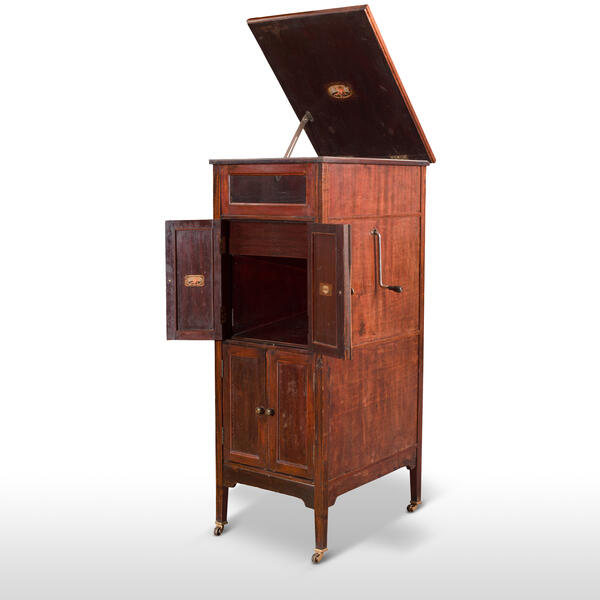The displayed floor-standing gramophone was produced in Riga in the early 20th century. It was in Riga that the first Russian record factory was established in 1902. Later, it also started producing gramophones. By then, such record players were already available in Russia. The citizens of St. Petersburg had been familiar with them since the 1890s.
The Riga factory was named “Recording Amour” and was owned by The Gramophone Co. Ltd., based in the United Kingdom. One of its members was Emil Berliner, an American inventor of the gramophone.
The gramophone from the museum collection consists of three main parts: a sound mechanism at the top, a sound tube in the middle, and a record storage cabinet at the bottom. One of the doors has an image of Cupid, the Greek god of love, sitting on a music record and holding a quill pen. The other door has the inscription “Amour 2G”, indicating the model of the device.
The history of the device dates back to 1877 when Thomas Edison invented the phonograph, the first device to reproduce sound. The sound was recorded on the surface of a rotating metal cylinder coated with a special alloy, on top of which was a layer of wax, and tinfoil. The phonograph appeared in the Russian Empire soon after its invention.
Emil Berliner invented his gramophone ten years later. It ensured a high quality of sound reproduction and became an international sensation. Gramophones quickly became widespread around the world. Their production was organized not only in the United States but also in Europe.
The early 20th century was marked by gramophone boom. Devices were designed for representatives of various social classes, and in the Russian Empire, they could cost anywhere from 15 to 1,000 rubles. The more expensive luxurious ones were made of mahogany with inlays, and their horns were made of silver instead of copper.
The museum has in its collection a floor-standing gramophone produced by the “Recording Amour” factory in Riga. It is perfectly preserved and can still be used to play records.



